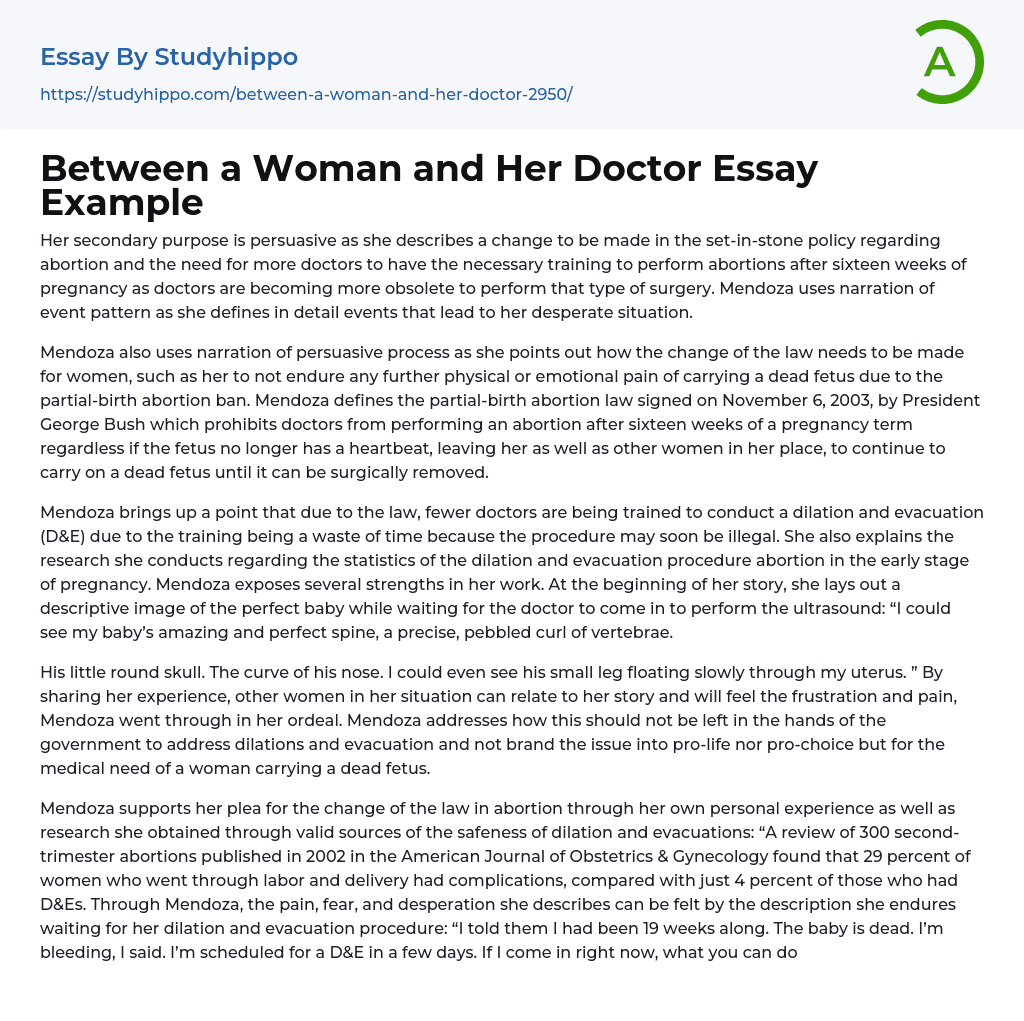Her secondary purpose is persuasive as she describes a change to be made in the set-in-stone policy regarding abortion and the need for more doctors to have the necessary training to perform abortions after sixteen weeks of pregnancy as doctors are becoming more obsolete to perform that type of surgery. Mendoza uses narration of event pattern as she defines in detail events that lead to her desperate situation.
Mendoza also uses narration of persuasive process as she points out how the change of the law needs to be made for women, such as her to not endure any further physical or emotional pain of carrying a dead fetus due to the partial-birth abortion ban. Mendoza defines the partial-birth abortion law signed on November 6, 2003, by President George Bush which prohibits doctors from performing an
...abortion after sixteen weeks of a pregnancy term regardless if the fetus no longer has a heartbeat, leaving her as well as other women in her place, to continue to carry on a dead fetus until it can be surgically removed.
Mendoza brings up a point that due to the law, fewer doctors are being trained to conduct a dilation and evacuation (D&E) due to the training being a waste of time because the procedure may soon be illegal. She also explains the research she conducts regarding the statistics of the dilation and evacuation procedure abortion in the early stage of pregnancy. Mendoza exposes several strengths in her work. At the beginning of her story, she lays out a descriptive image of the perfect baby while waiting for the doctor to come in to perform the ultrasound: “I could see my baby’s
amazing and perfect spine, a precise, pebbled curl of vertebrae.
His little round skull. The curve of his nose. I could even see his small leg floating slowly through my uterus. ” By sharing her experience, other women in her situation can relate to her story and will feel the frustration and pain, Mendoza went through in her ordeal. Mendoza addresses how this should not be left in the hands of the government to address dilations and evacuation and not brand the issue into pro-life nor pro-choice but for the medical need of a woman carrying a dead fetus.
Mendoza supports her plea for the change of the law in abortion through her own personal experience as well as research she obtained through valid sources of the safeness of dilation and evacuations: “A review of 300 second-trimester abortions published in 2002 in the American Journal of Obstetrics & Gynecology found that 29 percent of women who went through labor and delivery had complications, compared with just 4 percent of those who had D&Es. Through Mendoza, the pain, fear, and desperation she describes can be felt by the description she endures waiting for her dilation and evacuation procedure: “I told them I had been 19 weeks along. The baby is dead. I’m bleeding, I said. I’m scheduled for a D&E in a few days. If I come in right now, what you can do for me, I asked. ” Mendoza ends her story on a happy note of the new arrival of a healthy baby through another ultrasound while lying on the table viewing her child on a monitor and the doctor confirming her baby is fine.
Mendoza’s weakness
in her story is the lack of a description of the dilation and evacuation procedure as well as how she felt while lying on the surgery table before she was unconscious. At the end of Mendoza’s story, she leaves readers with a cliffhanger since she did not disclose the outcome of the trial of the possible change in the laws for partial abortion. Her readers would have to research the outcome of the trial.
Lastly, her story goes back and forth to her personal narration and display of facts. The statement of meaning of Mendoza’s personal experience of the shortage of access to dilations and evacuations deals with women's lives along with their health being in danger and the President’s ban on partial-birth abortion only increases that danger as well as the lack of training of physicians who will conduct the procedure.
Martha Mendoza’s experience is a touching story of how the change in the law needs to be made for other women who may be in the same situation as she and the end result possibly could end with their death. As she expressed in detail her desperation and seeking medical care in her situation possibly could change the minds of government leaders, medical boards, and pro-life protesters.
- Pro Choice essays
- Pro Life essays
- Should Abortion Be Legal essays
- Against abortion essays
- Abortion Debate essays
- Hospital essays
- Physician essays
- Health Care Provider essays
- Universal Health Care essays
- Readmission essays
- Sojourner Truth essays
- Abortion essays
- Abuse essays
- Animal Rights essays
- Animal Testing essays
- Assault essays
- Bullying essays
- Controversial Issue essays
- Crash essays
- Cyber Bullying essays
- Feminism essays
- Human Rights essays
- Immigration essays
- Inequality essays
- Poverty essays
- Prejudice essays
- Racism essays
- Torture essays
- Violence essays
- Administration essays
- Architect essays
- Discipline essays
- Doctor essays
- Engineer essays
- Farmer essays
- Hunter essays
- Labor essays
- Model essays
- Nurse essays
- Pilot essays
- Police Officer essays
- Professionalism essays
- Social Work essays
- Stakeholders essays
- Teamwork essays
- Addiction essays
- Anatomy and Physiology essays
- Biodegradation essays
- Cancer essays
- Dental Care essays




